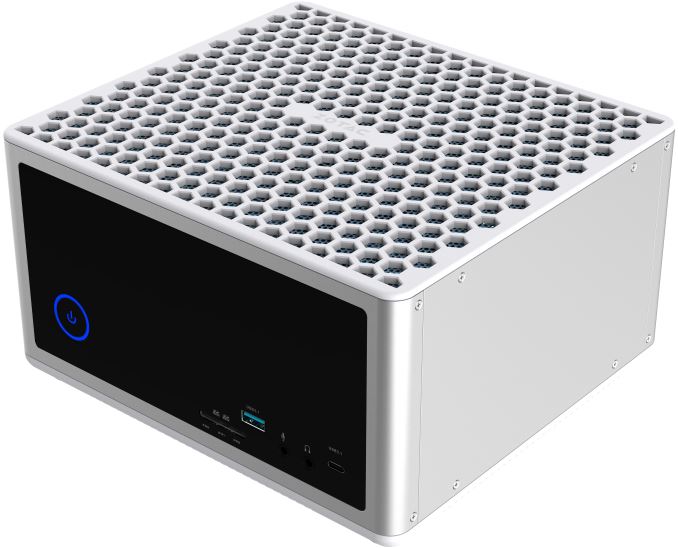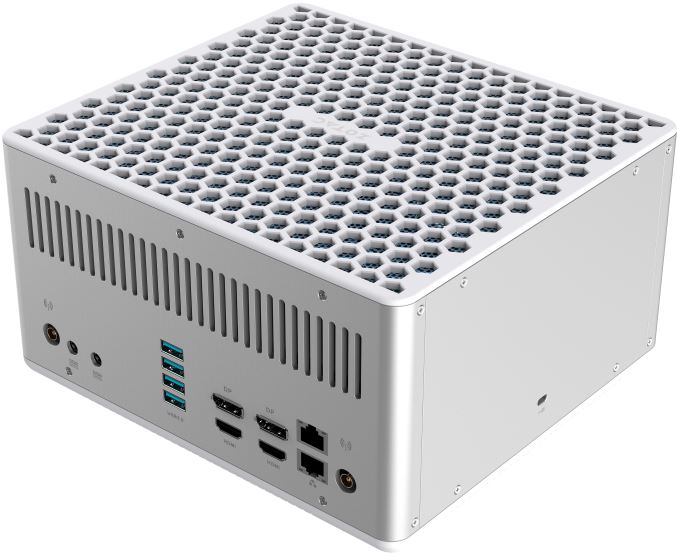ZOTAC MAGNUS EN980 Detailed - A SFF VR-Ready PC with GeForce GTX 980
by Anton Shilov on May 30, 2016 2:00 PM EST
Several months ago, ZOTAC introduced its ZBOX MAGNUS EN980 PC featuring NVIDIA’s GeForce GTX 980 Notebook GPU. It was positioned as one of the world’s smallest VR-Ready systems. This week, the company disclosed the final specifications of the machine, and also gave some insight into the internal layout. The dimensions of the MAGNUS EN980 are larger compared to its predecessors. However, its performance should indeed be enough for modern VR games.
The ZOTAC ZBOX MAGNUS EN980 is equipped with an Intel Core i5-6400 processor (4C/4T, 2.7 GHz/3.3 GHz, 6 MB LLC cache, 65 W TDP) as well as a custom LGA1151 motherboard with two slots for DDR3L-1600 memory. NVIDIA’s GeForce GTX 980 4 GB Notebook module, one M.2-2280 slot for a SATA SSD, a SATA connector, two Gigabit Ethernet controllers, a 802.11ac Wi-Fi / BT 4.0 module and a USB 3.1 controller make up the other important features. Zotac plans to launch three different versions - a barebones with just the CPU and GPU installed, a PLUS version with 8GB of DDR3-L and a 120GB M.2 SSD / 1TB 2.5" HDD without OS, and a WINDOWS edition similar to the PLUS, but, with Windows 10 Home pre-installed.
| ZOTAC ZBOX MAGNUS EN980 Specifications | |||
| ZBOX MAGNUS EN980 | ZBOX MAGNUS EN980 PLUS |
ZBOX MAGNUS EN980 WINDOWS |
|
| CPU | Intel Core i5-6400 (4 cores, 2.7 GHz/3.30 GHz, 6 MB LLC) | ||
| PCH | unknown | ||
| Graphics | NVIDIA GeForce GTX 980 Notebook: 2048 stream processors 128 texture units 64 ROP 256-bit memory interface 4 GB of GDDR5 memory |
||
| Memory | Two SO-DIMM slots, up to 16 GB of DDR3L-1600 | 8 GB of DDR3L | |
| Storage | One M.2 slot for SSDs One SATA connector for 2.5" SSD or HDD |
120 GB M.2 SSD 1 TB 2.5" HDD |
|
| Wi-Fi | 802.11ac + BT 4.0 | ||
| Ethernet | Two Gigabit Ethernet with RJ45 connector | ||
| Display Outputs | 2 HDMI (2.0?), 2 DisplayPort 1.2 |
||
| Audio | 3.5 mm audio in and audio out | ||
| USB | 4 USB 3.0 Type-A (5 Gbps) 1 USB 3.1 Type-A (10 Gbps) 1 USB 3.1 Type-C (10 Gbps) |
||
| Other I/O | 3-in-1 card reader (SD/SDHC/SDXC UHS II) | ||
| Dimensions | 225 mm × 203 mm × 128 mm | ||
| PSU | External, 2 × 180 W | ||
| OS | - | Windows 10 Home | |
From a performance perspective, the MAGNUS EN980 should meet the minimum requirements that Oculus VR has set for games compatible with the Oculus Rift VR headset: it has a quad-core CPU along with NVIDIA’s GeForce GTX 980 graphics card, which outperforms the AMD Radeon R9 290 and NVIDIA GeForce GTX 970 - the minimum graphics cards recommended by Oculus VR. In addition, the PC can support at least 3 TB of storage (1 TB SSD + 2 TB HDD) and officially supports 16 GB of DDR3L memory. Besides, the socketed nature of the CPU means that users can potentially upgrade it, if desired.
The MAGNUS EN980 system has a fine set of external ports, including two HDMI (2.0?), two DisplayPort 1.2, two GbE, four USB 3.0, one USB 3.1 Gen 2 Type-A and one USB 3.1 Gen 2 Type-C. In addition, the PC has a 3-in-1 card reader (SD/SDHC/SDXC UHS II). The GeForce GTX 980 Notebook should support HDMI 2.0, so it is likely that the 'HDMI 1.4' specified in the product brochure is a typo. The user manual (PDF) also mentions HDMI 2.0 support. In any case, the system does support four simultaneous display outputs.
Oculus Rift users will utilize three USB 3.0 receptacles as well as one HDMI port to connect their VR gear. Moreover, while the EN980 system is equipped with 3.5 mm audio in/out jacks, it does not have multi-channel analog audio outputs, which means that those, who would like to use 5.1/7.1 speaker systems will have to add a USB audio solution. As a result, some consumers might run out of USB ports, and might wanto to make use of a USB hub.
In terms of size, the MAGNUS EN980 (225 mm × 203 mm × 128 mm) seems to be comparable to typical mini-ITX systems and is clearly larger than any Intel NUC-like PCs, or ZOTAC's own ZBOX computers. To cool down the GPU (145 W TDP) and the CPU (65 W), ZOTAC has invented a special liquid cooling system (which slightly resembles Corsair’s low-profile H5 SF, but is clearly a different device) with a huge radiator and massive (likely 140 mm) fan. This cooling system as well as the GeForce GTX 980 module are the two primary reasons why the EN980 is a relatively large computer. To feed the PC, two external 180 W power supplies are required, which is something new in the world of SFF PCs.
The new ZBOX MAGNUS EN980 PCs is being demonstrated at Computex 2016 and will hit the market in the coming weeks. Pricing is still unknown, but, given the high performance and usage of sophisticated components, the EN980 is going to cost more than its predecessors.
Source: ZOTAC



















18 Comments
View All Comments
Tabalan - Monday, May 30, 2016 - link
I really hope for some high end Zen APU in such small or even smaller box. 6 cores + R9 470X (or even R9 480) would be really decent box for playing even quite demanding games, far better than laughable (in terms of gaming performance) Intel Skull Canyon.Lonyo - Monday, May 30, 2016 - link
Yay, more cheating "mini" systems with external power bricks. On the one hand it's reasonable because you aren't dumping at heat into the system, which helps, but it's not entirely honest to say how small your system is when it has a massive external power brick (or two).MonkeyPaw - Monday, May 30, 2016 - link
Yeah, that's what I hate about the XboxOne. It's a massive device, yet MS still went external power brick. PS4 is smaller and internal. Still, on this type of device, it's probably good to get some of the heat elsewhere, so temps and fan speeds don't get out of hand.Leonick - Monday, May 30, 2016 - link
Heat is definitely a valid reason to make the power supply external for small cases like this.Looking again at the Xbox One and PS4, the PS4 gets a lot hotter during use than the Xbox ever does. The fan in the PS4 is also quite a bit louder, though I'm not sure if that's because it's working much hard than the fan in the Xbox or if it's because it's simply just a cheap fan.
Samus - Monday, May 30, 2016 - link
I personally look at external power bricks as a cost cutting measure. It's cheap. Especially regarding monitors. All the high end monitors have internal global PSU's and they are still thin.Spunjji - Tuesday, May 31, 2016 - link
It's more efficient than an internal unit would be, reduces the size of the box itself and reduces the heat output and fan noise of the box. What's cheap about that?HomeworldFound - Monday, May 30, 2016 - link
This is the kind of system I'm interested in, only with a GTX 1060 when it arrives. I'd rather have an external power brick to conceal than the internal power supply, they all get to share a shelf together. I would actually like to see more companies providing solutions like this rather than these Intel CPU IGP combos that won't offer a satisfactory gaming experience.Cygni - Tuesday, May 31, 2016 - link
Yeah, I couldn't disagree more. I wish far more mini systems used external powerbricks to decrease the size of the box itself and, far more importantly, the heat and noise.damianrobertjones - Monday, May 30, 2016 - link
The marketing people need to make things CLEAR!"nVIDIA GeForce GTX 980 Notebook:" is NOT a 980. It's a 980m. All literature should state 980m or 980 notebook.
P.s. DDR3?
claudiu_io - Monday, May 30, 2016 - link
No, it's actually a full 980 with some reduced voltages (and frequencies): http://www.anandtech.com/show/9649/nvidia-gtx-980-...